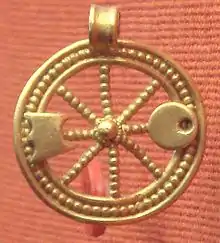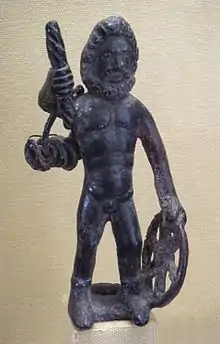Sulis
In the localised Celtic polytheism practised in Great Britain, Sulis was a deity worshiped at the thermal spring of Bath (now in Somerset). She was worshiped by the Romano-British as Sulis Minerva, whose votive objects and inscribed lead tablets suggest that she was conceived of both as a nourishing, life-giving mother goddess and as an effective agent of curses wished by her votaries.[1]

Etymology and name
The exact meaning of the name Sulis has been a matter of debate, but an emerging consensus among linguists regards the name as cognate with Old Irish súil ("eye, sight").[2][3][4]
A common Proto-Celtic root *sūli-, related to the various Indo-European words for "sun" (cf. Homeric Greek ηέλιος, Sanskrit sūryah, from c *suh2lio-) has also been proposed,[2] although the Brittonic terms for "sun" (Old Breton houl, Old Welsh heul) feature a diphthong that is absent from Sulis and they are not attested as a feminine form or with the -i- inflection.[3] Pierre-Yves Lambert argues for a Proto-Celtic form *su-wli-, composed of the prefix su- ("good") attached to the Celtic verbal theme *wel- ("to see").[2]
The medieval Welsh personal name Sulgen (< Sulien; "born from Sulis") and the Breton personal name Sul, borne by a local saint, are also related.[3]
Cult at Bath

Sulis was the local goddess of the thermal springs that still feed the spa baths at Bath, which the Romans called Aquae Sulis ("the waters of Sulis").[5] Her name primarily appears on inscriptions discovered in an extensive temple area to her at Bath, with only a single instance outside of Britain at Alzey, Germany.[6][7] This is not surprising, as Celtic deities often preserved their archaic localisation, remaining to the end associated with a specific place, often a cleft in the earth, a spring, pool or well. The Greeks referred to the similarly local pre-Hellenic deities in the local epithets that they assigned, associated with the cult of their Olympian pantheon at certain places (Zeus Molossos only at Dodona, for example). The Romans tended to lose sight of these specific locations, except in a few Etruscan cult inheritances and ideas like the genius loci, the guardian spirit of a place.
The gilt bronze cult statue of Sulis Minerva "appears to have been deliberately damaged" sometime in later Antiquity, perhaps by barbarian raiders, Christian zealots, or some other forces.[8]
Inscribed tablets
About 130 curse tablets, mostly addressed to Sulis, have been found in the sacred spring at the Roman baths in Bath.[9] Typically, the text on the tablets offered to Sulis relates to theft; for example, of small amounts of money or clothing from the bath-house. It is evident, from the localized style of Latin ("British Latin") used, that a high proportion of the tablets came from the native population.[10] In formulaic, often legalistic, language, the tablets appeal to the goddess Sulis to punish the known or unknown perpetrators of the crime until reparations are made. Sulis is typically requested to impair the physical and mental well-being of the perpetrator, by the denial of sleep, by causing normal bodily functions to cease or even by death. These afflictions are to cease only when the property is returned to the owner or disposed of as the owner wishes, often by its being dedicated to the goddess.[11] One message found on a tablet in the Temple at Bath (once decoded) reads: "Docimedis has lost two gloves and asks that the thief responsible should lose their minds [sic] and eyes in the goddess' temple."[12]

The tablets were often written in code, by means of letters or words being written backwards; word order may be reversed and lines may be written in alternating directions, from left to right and then right to left (boustrophedon). While most texts from Roman Britain are in Latin, two scripts found here, written on pewter sheets, are in an unknown language which may be Brythonic. They are the only examples of writing in this language ever found.[14]
Syncretism with Minerva
At Bath, the Roman temple was dedicated to Sulis Minerva as the primary deity of the temple spa. It is likely that devotion to Sulis existed in Bath before the Roman presence in the area, one of the reasons Sulis is named first in the syncretic Sulis Minerva.[15] Through the Roman Minerva syncresis, later mythographers have inferred that Sulis was also a goddess of wisdom and decisions.
Sulis was not the only goddess exhibiting syncretism with Minerva. Senua's name appears on votive plaques bearing Minerva's image while Brigantia also shares many traits associated with Minerva. The identification of multiple Celtic gods with the same Roman god is not unusual (both Mars and Mercury were paired with a multiplicity of Celtic names). On the other hand, Celtic goddesses tended to resist syncretism; Sulis Minerva is one of the few attested pairings of a Celtic goddess with her Roman counterpart.
Dedications to “Minerva” are common in both Great Britain and continental Europe, most often without any Celtic epithet or interpretation (cf. Belisama for one exception).
Solar goddess
Based on her name's etymology, as well as several other characteristics, such as the association with sight, civic law, and epithets relating to light, Sulis has been interpreted as a solar deity, at least in pre-Roman times. Some researchers have further suggested a role as the de facto Celtic solar deity, the associated Sulevia and similar names being the goddess's attestations elsewhere.[16][17][18]
Modern worship
Sulis has a number of modern-day worshipers among the Wiccan and pagan communities.[19] As of 1998, some people still deposited offerings in the waters of the Roman baths.[19]
References
- Joyce Reynolds and Terence Volk, "Review: Gifts, Curses, Cult and Society at Bath", reviewing The Temple of Sulis Minerva at Bath: vol. 2 The Finds from the Sacred Spring, in Britannia 21 (1990:379-391).
- Delamarre 2003, p. 287.
- Lambert 2008, p. 90.
- Zair, Nicholas (2012). Reflexes of the Proto-Indo-European Laryngeals in Celtic. Brill. p. 120.
- The standard introduction to the archaeology and architectural reconstruction of the sanctuary, with its classic temple raised on a podium at the center, and the monumental baths, with the sacred spring between them, is Barry Cunliffe, ed. Roman Bath (Oxford University Press) 1969.
- CIL XIII, 6266, Alzey (Altiaia, Roman Province of Germania Superior): Dea(e) Sul(i) / Attonius / Lucanu[s]
- Maier, Bernhard, 1963- (1997). Dictionary of Celtic religion and culture. Woodbridge, Suffolk: Boydell Press. ISBN 0-85115-698-3. OCLC 36074567.CS1 maint: multiple names: authors list (link)
- The Official Roman Baths Museum Web Site in the City of Bath
- Wilson, Roger (1988). A guide to the Roman remains in Britain. p. 109. ISBN 0094686807.
- Adams, J. N. (1992). "British Latin: The Text, Interpretation and Language of the Bath Curse Tablets". Britannia. Cambridge University Press. 93: 1–26. doi:10.2307/526102. JSTOR 526102.
- Cf. Fagan, Garrett G. (2002). Bathing in Public in the Roman World. p. 37. ISBN 0472088653., Gager, John G. (1999). Curse tablets and binding spells from the ancient world. pp. 194–195. ISBN 0195134826.
- Tomlin, Roger (1988). Tabellae Sulis: Roman inscribed tablets of tin and lead from the sacred spring at Bath. pp. 114–115. ISBN 0947816003.
- CIL VII, 53 = RIB 155.
- Tomlin, Roger (1987). "Was Ancient British Celtic Ever a Written Language?". Bulletin of the Board of Celtic Studies. University of Wales (34): 18–35. ISSN 0142-3363.
- Green, Miranda J. (Miranda Jane), 1947- (2004). The gods of the Celts (New pbk. ed.). Stroud: Sutton. ISBN 0-7509-3479-4. OCLC 56611355.CS1 maint: multiple names: authors list (link)
- Patricia Monaghan, The Encyclopedia of Celtic Mythology and Folklore, page 433.
- Kotch, John T., Celtic Culture: Aberdeen breviary-celticism, page 1636.
- Dexter, Miriam Robbins (Fall–Winter 1984). "Proto-Indo-European Sun Maidens and Gods of the Moon". Mankind Quarterly. 25 (1 & 2): 137–144.
- Marion Bowman (1998). "Belief, Legend and Perceptions of the Sacred in Contemporary Bath". Folklore. 109 (1–2): 28. doi:10.1080/0015587X.1998.9715958.
Bibliography
- Delamarre, Xavier (2003). Dictionnaire de la langue gauloise: Une approche linguistique du vieux-celtique continental (in French). Errance. ISBN 9782877723695.
- Lambert, Pierre-Yves (2008). "Gaulois Solitumaros". Études celtiques. 36 (1): 89–101. doi:10.3406/ecelt.2008.2303.
External links
![]() Media related to Sulis at Wikimedia Commons
Media related to Sulis at Wikimedia Commons

